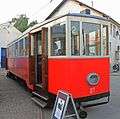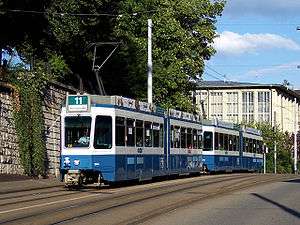Brown, Boveri & Cie
Brown, Boveri & Compagnie (BBC) was a Swiss group of electrical engineering companies. It was founded in Baden, Switzerland, in 1891 by Charles Eugene Lancelot Brown and Walter Boveri who worked at the Maschinenfabrik Oerlikon. In 1970 BBC took over the Maschinenfabrik Oerlikon. In 1988 it merged with ASEA to form ABB Group, a company producing DC Motors, AC motors, generators, turbines, transformers and the electrical equipment of locomotives. Some of BBC's technology went into German U-boats of World War II, such as the depth controls.
Sulzer steam engine and Brown-Boveri alternator from 1901 in the Electropolis museum in Mulhouse, France | |
| Industry | electrical engineering |
|---|---|
| Founded | 1891 |
| Defunct | 1 January 1988 (merged with ASEA to form the ABB Group) |
| Headquarters | |
Early History of BBC Brown Boveri
BBC Brown Boveri was established in 1891. The company was one of only a few multinational corporations to operate subsidiaries that were larger than the parent company. Because of the limitations of the Swiss domestic market, Brown Boveri established subsidiaries throughout Europe relatively early in its history, and at times had difficulty maintaining managerial control over some of its larger operating units. The merger with ASEA, a company which was praised for its strong management, was expected to help Brown Boveri reorganize and reassert control over its vast international network.
Activity in Britain
Brown Boveri's early activities included manufacturing electrical components such as electric motors for locomotives and power-generating equipment for Europe's railway systems. In 1919 the company entered into a licensing agreement with the British manufacturing firm Vickers which gave the British firm the right to manufacture and sell Brown Boveri products throughout the British Empire and in some parts of Europe. The agreement gave Brown Boveri a significant amount of money and the promise of substantial annual revenue, and also helped the company expand into foreign markets at a time when protectionist policies inhibited international expansion.
Activity in Continental Europe
.png)
In the early 1920s, Brown Boveri, already a geographically diversified company with successful operating subsidiaries in Italy, Germany, Norway, Austria, and the Balkans, suffered losses due to the devaluation of the French franc and the German mark. At the same time, in the Swiss domestic market, production costs increased while sales remained static, causing the company further losses. In 1924 Brown Boveri devalued its capital by 30 percent to cover the losses it had incurred. In 1927 the agreement with Vickers ran out and was not renewed. Besides the arrangement Brown Boveri had had with this British firm, it also had a somewhat similar relationship with Netherlands-based Heemaf which lasted well into the early 1960s when the Heemaf led the creation of Holec (Holland Electric).[1]
Growth
During the same time, Brown Boveri's various subsidiaries grew rapidly. Industrialization throughout Europe created strong demand for the company's heavy electrical equipment. Italy's burgeoning railroad industry provided a particularly strong boost to Brown Boveri's Italian subsidiary, and the company's German facility actually did considerably more business than the Swiss parent. For the next few decades Brown Boveri grew as fast as technological developments in electrical engineering. Each of the company's subsidiaries tended to develop individually, as if it were a domestic company in the country in which it operated, and broad geographic coverage helped insulate the parent from severe crises when a certain region experienced economic difficulties.
After World War II
After World War II, the Cold War presented a variety of business opportunities for defense-related electrical contractors, but Brown Boveri's subsidiaries were seen as foreign companies in many of the countries in which they operated, sometimes making it difficult for the company to win lucrative contracts involving sensitive technology and other government contracts. The company, nevertheless, excelled at power generation, including nuclear power generators, and prospered in this field. Electrification in the Third World also provided Brown Boveri with substantial profits.
Reorganization of Brown Boveri in 1970
In 1970 Brown Boveri began an extensive reorganization. The company's subsidiaries were divided into five groups: German, French, Swiss, "medium-sized" (seven manufacturing bases in Europe and Latin America), and Brown Boveri International (the remaining facilities). Each of these groups was further broken down into five product divisions: power generation, electronics, power distribution, traction equipment, and industrial equipment.
The United States
Throughout the 1970s, Brown Boveri struggled to expand into the US market. The company negotiated a joint venture with Rockwell, the American manufacturer of high-tech military and aerospace applications, but the deal fell through when the two companies could not agree on financial terms. While Brown Boveri counted a handful of major U.S. customers as its clients, among them large utilities such as the Tennessee Valley Authority and American Electric Power's Nuclear Plant in south west Michigan DC Cook Unit 2 steam turbine, Brown Boveri's American market share was low considering the company's international standing (North American sales accounted for only 3.5 percent of total sales in 1974 and 1975), and the company continued to search for a means of effectively entering U.S. markets.
Great Britain
During the electrification of the British West Coast Main Line in the early 1970s, Brown Boveri traction insulators were used.
In 1974 Brown Boveri acquired the British controls and instrument manufacturer, George Kent Group. The deal at first raised concern in Britain over foreign ownership of such highly sensitive technology, but Brown Boveri prevailed with the encouragement of George Kent's rank-and-file employees, who feared the alternative of being bought by Britain's General Electric Company (GEC). The newly acquired company was renamed Brown Boveri Kent.
The Middle East and Africa
In the mid-1970s growing demand in the Middle East for large power-generating facilities distracted the company from its push into North America. Oil-rich African nations, like Nigeria, attempting to diversify their manufacturing capabilities also created new markets for Brown Boveri's heavy electrical engineering expertise.
The 1980s
In the early 1980s Brown Boveri's sales flattened out and the company's earnings declined. In 1983 Brown Boveri's German subsidiary in Mannheim, West Germany, which accounted for nearly half of the entire parent company's sales, rebounded. In spite of an increase in orders, the company's cost structure kept earnings down. In 1985 the subsidiary's performance improved as a result of cost-cutting measures but price decreases in the international market and unfavorable shifts in currency exchanges rates largely offset these gains. In 1986 the parent company acquired a significant block of shares in the Mannheim subsidiary, bringing its total stake to 75 percent.
Unification of research
In the later 1980s Brown Boveri took steps to reduce duplication of research and development among its various groups. While each subsidiary continued to do some product-development research for its individual market, theoretical research was unified under the parent company, making more efficient use of research funding.
Supercharger development
In 1987 the company introduced a supercharging system for diesel engines called Comprex. This system was capable of increasing an engine's horsepower by 35 percent and delivering up to 50 percent more torque at lower speeds. The Japanese automaker Mazda planned to use the new supercharger in its new diesel passenger models.
Locomotives and railcars
Electric
Gas turbine
Gallery
 Brown Boveri electric locomotive of 1911
Brown Boveri electric locomotive of 1911- Brown Boveri electric locomotive of 1929
- Brown Boveri gas turbine-electric locomotive, British Rail 18000, built 1949
 Brown, Boveri & Cie tram from pre-WWII period in Belgrade, Serbia
Brown, Boveri & Cie tram from pre-WWII period in Belgrade, Serbia
References
- Jasper Faber. The Perils and Advantages of Licensing Technology in the Electrical Equipment Industry: Heemaf 1908-1970 http://www.gtg.tu.berlin.de/.../306-jasper-faber-the-perils-and-advantages...
External links
- Brown, Boveri & Cie in the Dodis database of the Diplomatic Documents of Switzerland
- Documents and clippings about Brown, Boveri & Cie in the 20th Century Press Archives of the ZBW
